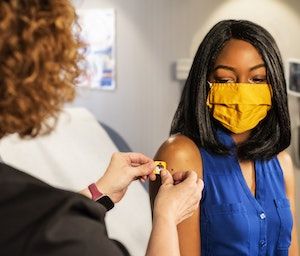Strategies to Address COVID-19 Vaccine Hesitancy Among Minority Communities
Discriminately affected populations face a wall of hurdles, historic and contextual, in buying into COVID-19 vaccine benefit. What can clinicians and public health officials do to help?

A lack of medical education, as well as a long-standing history of systemic racism and discrimination which resulted in decades-long distrust of the US healthcare system, has resulted in significant COVID-19 vaccine hesitancy among minority communities, according to a new review paper.
Now, when US adult COVID-19 vaccine sits beneath 60%, investigators are taking aim at improved messaging and education for specific racial and ethnic minority groups in the US, in order to improve COVID-19 protection among the discriminately affected populations, as well as aide the US in achieving possible vaccine-produced herd immunity against the pandemic virus.
In their review, published in Vaccines, James E.K. Hildreth, PhD, MD, and Donald J. Alcendor, PhD, of the Center for AIDS Health Disparities Research, Department of Microbiology and Immunology, School of Medicine, at Meharry Medical College, provided what they defined as a “analysis or snapshot” of COVID-19 vaccine hesitancy currently among minority US communities.
As they noted, despite being notably more vulnerable to SARS-CoV-2 infection and complicated disease from infection, minority communities have been associated with significantly greater likelihood of hesitancy following the US Food and Drug Administration (FDA) Emergency Use Authorization (EUA) for the 3 currently available COVID-19 vaccines.
Hildreth and Alcendor cited a study showing that just one-fourth (25%) of African Americans and just more than one-third (37%) of Hispanic/Latino individuals expressed interest in getting a COVID-19 vaccine, versus 56% of non-Hispanic Whites.
Among the key barriers that stand in the way of developing herd immunity—defined as ≥75% population immunity from the virus—include: misinformation and fear; conspiracy theories; lack of awareness or education; institutionalized racism; poor social determinants of health; “antivaxxer” messaging; vaccine politicization; vaccine supply and global equity; and viral variants and pace of vaccinations.
“This review explores various issues and consequences associated with vaccine hesitancy among minority populations in the US, as well as strategies for combating vaccine hesitancy and promoting equity in COVID-19 vaccination,” they wrote.
Defining Vaccine Hesitancy
Vaccine hesitancy, they noted, is a generally complex perspective influenced by a person’s race and ethnicity—but also their age, gender, income, health insurance access, religious beliefs, political affiliations, education, and general trust of healthcare establishments.
In the context of COVID-19, pandemic-specific matters including vaccine supply shortages or delays—especially apparent in vaccination sites that serve greater minority populations—may be enough to dissuade an uncertain individual from receiving a dose.
“A virtual world summit that meets regularly may be a viable step to identify barriers against global vaccine equity as well as to ensure that low-income countries and marginalized populations have access to COVID-19 vaccines,” Hildreth and Alcendor wrote. “Strategies to facilitate continual vaccinations and vaccine development as well as to curtail the evolution of viral variants are critical.”
Healthcare Worker Influence
What’s more, under-vaccinated communities and groups may be influenced by vaccine hesitancy expressed by trusted healthcare providers. Though the authors noted a strong correlation between physician recommendation and patient vaccine acceptance, they also highlighted cross-sectional research showing 56% of 3479 surveyed healthcare workers were unsure or hesitant to take a COVID-19 vaccine.
Again, among healthcare workers, the influences of hesitancy were diverse.
“Vaccine acceptance increased with age, education level, and income level. A smaller percentage of African American (19%), Latinx (30%), and rural (26%) healthcare workers were willing to take the vaccine,” they wrote. “COVID-19 vaccine safety (69%), effectiveness (69%), and speed of development/approval (74%) were the major concerns of these participants.”
Antivax Messaging
Lastly, Hildreth and Alcendor highlighted the influence of the antivax movement, which in recent years has expanded on a global scale, with more organization and “significant financial support.”
Among the “outrageous claims” made by such groups against the benefit of vaccines include: their contamination with harmful additives; their influence on allergy development; their development of autism in children; their role in a conspiracy between the pharmaceutical industry and the federal government.
“Many antivaxxers also view vaccination as an infringement on personal liberty,” they stressed. “By not accepting safe and effective vaccines, antivaxxers can impose undue harm on society.”
The pair suggested social media- and internet-based campaigns against antivax misinformation, particularly on the matter of currently available COVID-19 vaccines. Though COVID-19 vaccines have also been propped in political discourse in “unprecedented ways” during their development and rollout, there is a need to preserve the sanctity of the science-based platform by which they supported, Hildreth and Alcendor wrote.
Solutions
Among their strategies toward targeting vaccine hesitancy and achieving greater COVID-19 vaccination equity in the US, the pair emphasized the need for improved minority community access to vaccine clinical trials during assessment, and authorized COVID-19 vaccines during rollout.
Among messaging platforms, they highlighted radio commentaries, multilingual literature, community-based surveying, and individual interviews as key targeting methods for interpreting and addressing COVID-19 vaccine hesitancy. They also encouraged virtual town hall meetings, led by community figures and local healthcare providers, to allow for questions and concerns to be heard by minority healthcare influencers.
Additionally, culturally-sensitive approaches to vaccine distribution and processing are needed. They suggested expansion of vaccination sites to include unconventional venues including regional Department of Motor Vehicles facilities, restaurants, churches, salons, coffee shops, grocery stores, and more.
It’s important, the experts argued, for the US to set a precedent in low-income and underserved community access to COVID-19 vaccines.
“A high level of vaccine acceptance across all populations in the US is essential to mitigating the further transmission of SARS-CoV-2 and its variants as well as to achieving herd immunity,” they concluded. “The devastations that COVID-19 has inflicted on our communities, economy, and health are a stark reminder that we must always be prepared for future pandemics and that no one is truly isolated in this global community.”
